
Students examine the characterization of a character in a novel or short story to complete the "Autopsy of a Protagonist" slideshow.
- Subject:
- English
- Fiction
- Material Type:
- Assessment
- Author:
- Deb Wilkinson
- Date Added:
- 03/28/2021

Students examine the characterization of a character in a novel or short story to complete the "Autopsy of a Protagonist" slideshow.
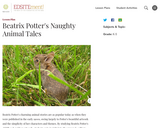
Through studying Beatrix Potter's stories and illustrations from the early 1900s and learning about her childhood in Victorian England, students can compare/contrast these with their own world to understand why Potter wrote such simple stories and why she wrote about animals rather than people.
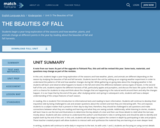
In this unit, students begin a year-long exploration of the seasons and how weather, plants, and animals are different depending on the season by studying the beauties of fall and fall harvests. Students launch the unit by setting up an ongoing weather experiment in order to understand the patterns of fall and how weather changes during fall. While gathering on-going data about the changing weather in fall, students will learn and observe what happens to leaves in the fall and notice the difference between various types of leaves. In the second half of the unit, students explore the different harvests of fall, particularly apples and pumpkins, and discuss the basic life cycles of both. This unit is a chance for students to stop and think about the changes that are happening in the natural world around them and why the changes happen. It is our hope that by the end of the year, after studying winter and spring in subsequent units, students will have a deeper understanding of the unique features of each season.
In reading, this is students' first introduction to informational texts and reading to learn information. Students will continue to develop their inquisitive side by being challenged to ask and answer questions about the content and text they are interacting with. This unit exposes students to a subject matter that is present in their day-to-day lives; therefore, they should be challenged to ask questions and make connections between what they are reading and learning and what they are seeing outside. Additionally, while listening to stories, students will learn how to use the text and illustrations to determine the key details of a text and then use those details to retell what the text was mostly about. Students will also continue to understand the author's and illustrator's roles in writing texts and should be able to identify and explain both by the end of the unit. In this unit, students will also begin to explore the content in-depth by participating in labs and projects. These teacher-created projects will allow students to interact with and synthesize the material they are learning at an even deeper level.
In writing, students will continue to write daily in response to the text. As with units 1 and 2, students are focusing on using correct details from the text to answer the question. Students should be using a combination of words and pictures, depending on the student's development as a writer. Daily teaching points, based on student data, should be included to ensure that students are progressing as writers.
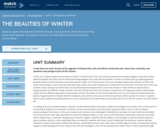
In this unit, students explore the beauties of winter. In the first part of the unit students pretend to be meteorologists as they learn about different weather forecasts and the words that meteorologists use to describe the weather in winter. Students start by exploring generic weather words and then transition into winter-specific words. In the second part of the unit, students explore how animals survive in the winter and the ways in which animals meet their basic needs, even when the ground is covered with ice and snow. In the last part of the unit, students read a variety of Jan Brett texts and use what they have learned about snow and animals to make inferences about what is happening with the different winter animals in the text. By the end of the unit, students should have a strong grasp of what makes winter unique and the different ways plants and animals survive in the winter. Due to the timing of this unit, it is our hope that students will have plenty of opportunities to interact with the vocabulary and content in the natural world around them. When outside for recess or anytime that it snows, students should be pushed to use the vocabulary and content they are learning in the unit so that the content can fully come to life.
In reading, this unit is predominately a collection of informational texts and builds on skills and strategies from earlier units. At this point it is assumed that students are inquisitive consumers of text and are able to ask and answer questions about a text in order to deepen understanding of the content. In this unit, students will continue to be challenged to identify the main topic of a text, retell the key details that connect to the main topic, describe the connection between ideas in a text, and use the illustrations and words to describe and retell what is happening in a text with varying levels of teacher support. Students will also begin to use strategies to ask and answer questions about unknown words in a text, specifically those connected to weather and snow. As part of daily text introductions, students will also continue to explore the purpose behind text features, specifically the front cover, back cover, and title page of a book, and how each feature supports understanding of the text. Many of the skills and strategies in this unit are spiraled from earlier units or will be spiraled through upcoming units; therefore, it is up to the teacher to decide what level of support students need with the particular strategy and scaffold accordingly.
In writing, students will continue to write daily in response to the text. At this point in the year, students should be using a combination of drawing and words to correctly answer the question. Pick focus teaching points based on data from previous units and individual student needs.

Noh, the oldest surviving Japanese dramatic form, combines elements of dance, drama, music, and poetry into a highly stylized, aesthetic retelling of a well-known story from Japanese literature, such as The Tale of Genji or The Tale of the Heike. This lesson provides an introduction to the elements of Noh plays and to the text of two plays, and provides opportunities for students to compare the conventions of the Noh play with other dramatic forms with which they may already be familiar, such as the ancient Greek dramas of Sophocles. By reading classic examples of Noh plays, such as Atsumori, students will learn to identify the structure, characters, style, and stories typical to this form of drama. Students will expand their grasp of these conventions by using them to write the introduction to a Noh play of their own.

This guided reading of Edgar Allan Poe’s “The Bells” (1848) focuses on developing student understanding of imagery and other figurative language, strengthening reading comprehension, and strengthening expository and persuasive writing skills.
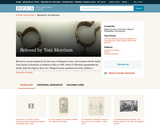
This collection uses primary sources to explore Toni Morrison's Beloved. Digital Public Library of America Primary Source Sets are designed to help students develop their critical thinking skills and draw diverse material from libraries, archives, and museums across the United States. Each set includes an overview, ten to fifteen primary sources, links to related resources, and a teaching guide. These sets were created and reviewed by the teachers on the DPLA's Education Advisory Committee.

Students will read a fiction text to create a journal in the voice of a character of their choice. Students will record noticings about the character's characterization and how incidents in the plot lead to a change in their character.
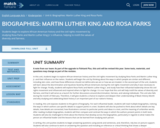
In this unit, students begin to explore African-American history and the civil rights movement by studying Rosa Parks and Martin Luther King Jr. and their influence on the nation. Students will begin the unit by thinking about the ways in which people are similar and different, including skin color, and how those differences should not define who we are or how we are treated. In the second part of the unit, students will learn about the discrimination and injustices faced by African-Americans during the civil rights movement and why it was necessary to fight for change. Finally, students will explore Rosa Parks and Martin Luther King Jr. and study how their influential leadership drove the civil rights movement and influenced and inspired others to fight for change. It is our hope that this unit will help instill the values of diversity and fairness, and that it will serve as a launch for further discussions around discrimination, fairness, and valuing individuals. This unit also falls during the month of February. Therefore, it will give students a chance to explore and deepen their understanding of Black History Month and why studying and celebrating black history is an important part of our nation's history.
In reading, this unit exposes students to the genre of biography. For each influential leader, students will read multiple biographies, noticing the ways in which authors use specific details to support points in a text. Students will also be pushed to think about which details are key details, how details are connected, how illustrations connect to particular points and ideas in a text, and the meaning of unfamiliar words. After reading multiple biographies, students will then compare and contrast the ways in which the authors present points in both texts. Students will also be challenged to think about the themes that develop across the biographies, particularly in regards to what makes the person an influential leader and the lessons that can be learned from studying each person.
In writing, this unit pushes students to begin answering questions using words and sentences, and, therefore, rely less on picture support. Students will also continue to work on answering the question and including an inference or critical thinking that shows a deeper understanding of the text. At this point, all structure focus correction areas should be taught; therefore, the focus of this unit should be on providing individualized feedback to students who are not at a 3 or 4 on the rubric.
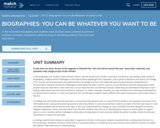
In this biography unit, students read and learn about a diverse assortment of artists, musicians, and dancers. By reading a wide variety of biographies, students will be challenged to think about where people get their inspiration, how a person's decisions and actions can change his or her life, and how hard work and determination can change a person's life, especially when facing instances of prejudice and discrimination. Students will also be challenged to think about the ways in which a person can be influential and how reading about other people's lives can help them in their own lives. It is our hope that this unit will help students realize they can be whatever they want to be if they are determined and work hard, and that no obstacle, no matter how big it may feel, can stop someone from achieving something they are determined to achieve. It is also our hope that this unit will open students' eyes to different life paths and passions, particularly those in the arts.
In reading, this unit builds onto the work done in previously informational units. It is assumed that students are inquisitive consumers of an informational text, asking and answering questions about key details. It is also assumed that students are able to find the main topic of a text and retell key details that fit with the main idea. In this unit, students will focus deeply on cause and effect and describing the connection between individuals, events, and information from the text. Another main focus is on identifying the reasons an author gives to support points in a text. Students will be challenged to think about the big ideas of a text and what details the author includes in both the text and illustrations to support the key ideas.
In writing, students will continue to write daily in response to the text. At this point, students should be fluid in writing about the text in a structured way. Therefore, the focus of this unit is on pushing students to include the best and most accurate evidence and then to explain the evidence with inferences or critical thinking.
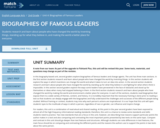
In this biography-based unit, second graders explore biographies of famous leaders and change agents. The unit has three main sections. In the first section students research and learn about people who have changed the world by inventing things. In this section students will explore the ways in which inventions can change the world and what it takes to turn an idea into action. In the second section students research and learn about people who have changed the world by standing up for what they believe in and fighting for what others think is impossible. In this section second graders explore the ways some leaders have persevered in the face of obstacles and stood up for themselves or ideas when many had stopped believing in them. In the third section students research and learn about people who have changed the world by making the world and environment a better place for everyone. In each of the sections, students read biographies that expose them to a wide variety of themes, content, and history. It is incredibly important that the necessary framing is done prior to reading a text so that students can deeply engage with the biographies and fully understand the challenges and successes of the different people being studied. Without framing or context, students may miss why each person's actions are inspirational. It is our hope that this unit will open students' eyes to the multitude of ways in which a person, regardless of race or gender, can influence and inspire change.
For readers, this unit is a combination of read-aloud and shared reading. At this point in the year second graders have been exposed to almost all of the high-frequency informational reading standards; therefore, this unit is a chance to review some standards and skills students need to practice. Two new standards that are a focus in this unit, however, are describing how reasons support particular points the author makes in a text and also comparing and contrasting the most important points presented by two texts on the same topic. Compare and contrast in this unit should go deeper than text features and structures. Although students can note differences in text features, the main focus should be on comparing and contrasting the different points and the reasons the authors use to support the points in two texts about the same person.

In this unit students explore the Taliban influence on the Middle East through the eyes of multiple young women. In the core text, The Breadwinner, students experience how the Taliban presence in Afghanistan drastically altered Parvana and her family's life. Students will be challenged to think about what constitutes basic human rights and the way in which the Taliban violated the human rights of many Afghanistan citizens. Students will also be challenged to think about women's rights, especially in regard to education and freedom, and how both were constantly at risk under Taliban rule. Finally, students will realize that a positive attitude, dedication to family, and drive to be self-reliant can help people survive, and thrive, in the worst of situations. In the second part of the unit, students read about the experiences of real children living in Afghanistan after the Taliban left. Through those experiences, students explore how education and women's rights are still restricted in Afghanistan and grapple with what it will take to create a society where women have access to the same basic freedoms as men. In the last part of the unit, students meet Malala Yousafzai and analyze how her positive attitude and drive help her fight for women's rights in Pakistan despite facing incredible challenges and threats. Over the course of the entire unit, it is our hope that students will build a deeper understanding of the importance of women's rights and access to education around the world, particularly in the Middle East.
As readers, this unit builds onto unit one by pushing students to compare and contrast characters and analyze character point of view at an even deeper level. Students will be challenged to close read the text, make accurate annotations, and quote accurately in order to develop theories about key characters in and across texts. In this unit, students will also begin to use informational texts, particularly memories and first-person accounts, to help build a deeper understanding of fiction texts. The focus for informational reading is similar to the focus for fiction, and students will analyze how the point of view influences the way in which events are described.
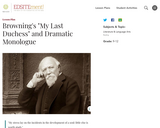
Reading Robert Browning's poem "My Last Duchess," students will explore the use of dramatic monologue as a poetic form, where the speaker often reveals far more than intended.
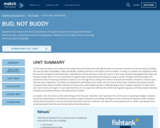
In this historical fiction unit, students learn about the Great Depression through the eyes of a ten-year-old African-American boy by reading the core text Bud, Not Buddy. In Bud, Not Buddy, students join Bud on his quest to find his father. In doing so, students are exposed to what life was like during the Great Depression, especially for African-Americans. Over the course of the novel, students will grapple with lying, and if lying is always bad or if it can sometimes be a good thing, as they witness Bud lying as a way to survive. Students will also analyze and explore the idea of maturity and what it means to act one's age versus acting more mature as Bud finds himself in situations most ten-year-olds will never experience. The theme of compassion and kindness also arises over the course of the novel. Students will analyze how the compassionate actions of others help Bud on his journey, while deepening their understanding of why it's always important to help others, even when times are tough. It is our hope that this unit, in conjunction with the rest of the fourth-grade sequence, will help students develop empathy and understanding for the experiences of others.
As readers, this unit serves as the culminating unit for the year. Therefore, the majority of the unit focuses on spiraling strategies. Students should be pushed daily to summarize key events, analyze characters and setting, and figure out the meaning of unknown words. Students should also be pushed to use the information they learn from the nonfiction text about the Great Depression to confirm and deepen their understanding of what life was like during the Great Depression.

This guided reading of Edgar Allan Poe’s “The Cask of Amontillado” (1846) focuses on expanding vocabulary, developing student understanding of imagery and other figurative language, strengthening reading comprehension, and strengthening expository and persuasive writing skills.
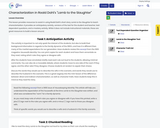
This lesson provides resources to assist in using Roald Dahl's short story Lamb to the Slaughter to teach characterization. It provides an anticipatory activity, versions of the text for the student and teacher, text-dependent questions, and a mastery activity. While it does not include instructional materials, these are great resources to build a lesson around.
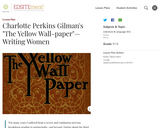
Using the landmark feminist short story "The Yellow Wall-paper," students will employ close reading concepts to analyze setting, narrative style, symbol, and characterization.
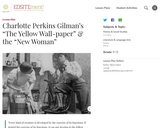
Charlotte Perkins Gilman's story "The Yellow Wall-paper" was written during atime of change. This lesson plan, the first part of a two-part lesson, helps to set the historical, social, cultural, and economic context of Gilman's story.
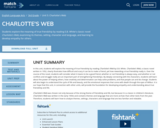
In this unit, students will explore the meaning of true friendship by reading Charlotte's Web by E.B. White. Charlotte's Web, a classic novel written in 1952, clearly illustrates how difficult and scary it can be to make a friend, yet how rewarding a true friendship really is. Over the course of the novel, students will consider what it means to be a good friend, whether or not friendship is always easy, and whether or not conflicts and struggle really are an important part of strengthening friendships. By deeply connecting with the characters, students will learn about the power of helping others, how creativity and determination can help solve problems, and that people can and do change. Students will also begin to understand the cycle of life and beauty, and the emotional responses that come with death through the eyes of Wilbur. It is our hope that this unit, in connection with other units, will provide the foundation for developing empathy and understanding about true friendship and life.
Charlotte's Web was chosen not only because of the strong theme of friendship and life, but because it is a classic in children's literature. Charlotte's Web was written in the early 1950s and contains themes and language that are more archaic than other texts from the year. Therefore, students will learn how to analyze themes, settings, characters and language that are less familiar and relatable.
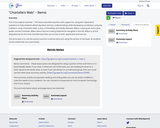
This is the original overview - This lesson provides teachers with support for using text-dependent questions to help students derive big ideas and key understandings while developing vocabulary using the children's novel, Charlotte's Web. A story of friendship and loyalty between Wilbur, a spring pic and a grey spider named Charlotte. Wilbur learns that he is being fattened for slaughter in the fall. Wilbur is at first disgusted by the fact that charlotte eats flies, but comes to both appreciate and love her.The remix plan is to use the actual novel but could be done just using this section of the book. All students would create their own summaries.